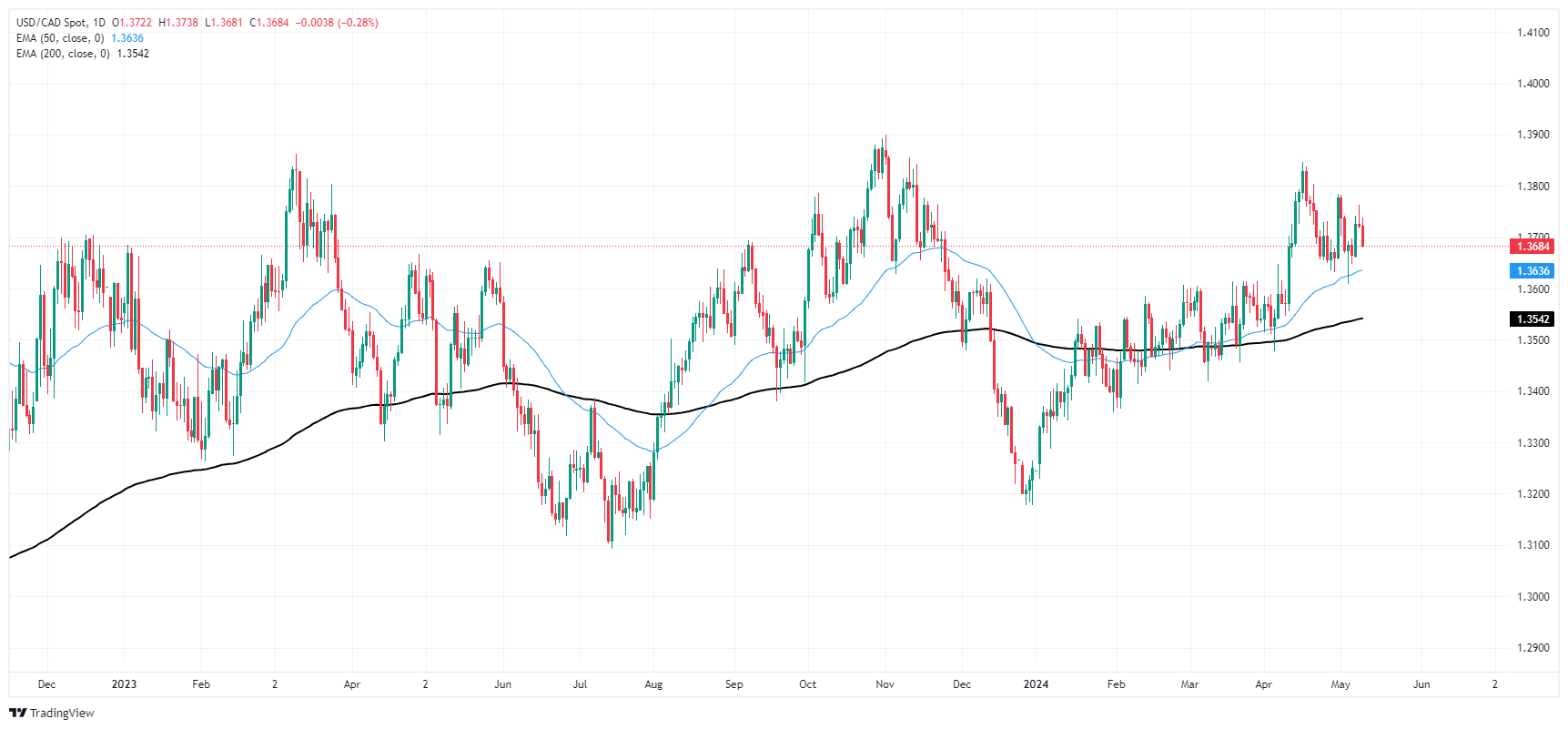- The Canadian dollar is supported by broad risk sentiment in the market.
- Canada has a resilient financial system, according to the BoC's Macklem.
- Canadian jobs numbers will be released on Friday.
The Canadian Dollar (CAD) found some bids on Thursday after investors' risk appetite increased, driving markets away from safe havens like the US Dollar (USD). The Dollar weakened overall and CAD traders found new buying momentum.
The Bank of Canada (BoC) presented its latest review of the financial system during Thursday's session in the US markets. BoC Governor Tiff Macklem assured market participants that the Canadian financial system remains “resilient” overall, with the BoC chief noting that signs of stress are increasing. BoC Deputy Governor Carolyn Rogers also noted that while the number of small businesses filing for insolvency has increased, the BoC does not believe this has broader implications for the Canadian economy.
Daily Market Moves Summary: Canadian Dollar Rising Again as BoC Downgrades Risks
- BoC Governor Macklem:
- The Canadian financial system remains resilient.
- Market expectations about the timing of rate cuts could introduce volatility.
- The adaptation of financial institutions to higher rates poses a risk to financial stability.
- Indicators of financial stress have increased.
- Rogers, BoC Deputy Governor:
- The number of small businesses filing for insolvency has increased, but it could simply mean a normalization after years of subpar filings.
- Crude oil markets remain lukewarm, reducing CAD's upside potential.
- Friday will close the week with Canadian labor numbers.
- The Canadian unemployment rate is expected to rise from 6.1% to 6.2%.
- The Canadian net employment change for April is expected to show a net increase of 18,000 new jobs, compared to a decline of -2,200 the previous month.
Price of the Canadian Dollar today
Below is the percentage change of the Canadian Dollar (CAD) against the currencies listed today. The Canadian dollar appreciated against the Japanese yen.
| USD | EUR | GBP | CAD | AUD | JPY | NZD | CHF | |
| USD | -0.22% | -0.07% | -0.24% | -0.39% | 0.19% | -0.22% | -0.06% | |
| EUR | 0.22% | 0.15% | -0.02% | -0.16% | 0.37% | 0.00% | 0.16% | |
| GBP | 0.06% | -0.15% | -0.16% | -0.31% | 0.22% | -0.14% | 0.01% | |
| CAD | 0.25% | 0.04% | 0.19% | -0.14% | 0.43% | 0.04% | 0.19% | |
| AUD | 0.39% | 0.15% | 0.31% | 0.13% | 0.52% | 0.16% | 0.30% | |
| JPY | -0.20% | -0.37% | -0.21% | -0.39% | -0.51% | -0.34% | -0.22% | |
| NZD | 0.21% | 0.00% | 0.15% | -0.04% | -0.18% | 0.39% | 0.14% | |
| CHF | 0.08% | -0.14% | 0.01% | -0.17% | -0.31% | 0.22% | -0.14% |
The heat map shows the percentage changes of the major currencies against each other. The base currency is chosen in the left column, while the quote currency is chosen in the top row. For example, if you choose the Euro in the left column and scroll down the horizontal line to the Japanese Yen, the percentage change that appears in the box will represent EUR (base)/JPY (quote).
Technical analysis: The Canadian dollar recovers ground in the face of the dollar's decline
The Canadian dollar advances strongly this Thursday, prolonging the rebound that began in the middle of the week. The Canadian dollar advances around a third against the US dollar, and rises four tenths against the Japanese yen (JPY).
USD/CAD was dragged lower on the day, retreating below the 200 hourly EMA at 1.3708, and approaching a short-term supply zone between 1.3660 and 1.3610. This week's bullish swing faltered from 1.3760, and swing highs are having a hard time taking hold.
The candlesticks continue to trade north of 1.3650, while the pair finds support at the 50-day EMA at 1.3636. Despite a short-term bearish tilt pushing the pair down from the latest swing high at 1.3850, the pair is still up on the year, trading up 3.3% from 2024 opening bids at 1.3246.
USD/CAD hourly chart
USD/CAD daily chart
Frequently Asked Questions about the Canadian Dollar
The key factors that determine the price of the Canadian Dollar (CAD) are the level of interest rates set by the Bank of Canada (BoC), the price of Oil, Canada's main export product, the health of its economy, the inflation and the trade balance, which is the difference between the value of Canadian exports and its imports. Other factors are market sentiment, that is, whether investors bet on riskier assets (risk-on) or look for safe havens (risk-off), with the risk-on being positive for the CAD. As Canada's largest trading partner, the health of the US economy is also a key factor influencing the Canadian dollar.
The Bank of Canada (BoC) exerts significant influence over the Canadian Dollar by setting the level of interest rates that banks can lend to each other. This influences the level of interest rates for everyone. The BoC's main objective is to keep inflation between 1% and 3% by adjusting interest rates up or down. Relatively higher interest rates are usually positive for the CAD. The Bank of Canada can also use quantitative easing and tightening to influence credit conditions, with the former being negative for the CAD and the latter being positive for the CAD.
The price of oil is a key factor influencing the value of the Canadian Dollar. Oil is Canada's main export, so the price of oil tends to have an immediate impact on the value of the CAD. Generally, if the price of oil rises, the CAD also rises, as aggregate demand for the currency increases. The opposite occurs if the price of oil falls. Higher oil prices also tend to lead to a higher probability of a positive trade balance, which is also supportive for the CAD.
Although inflation has traditionally always been considered a negative factor for a currency, since it reduces the value of money, the truth is that in modern times the opposite has happened with the relaxation of cross-border capital controls. Inflation tends to lead central banks to raise interest rates, which attracts more capital from investors around the world looking for a lucrative place to store their money. This increases the demand for the local currency, which in the case of Canada is the Canadian Dollar.
The macroeconomic data that is released measures the health of the economy and can influence the Canadian dollar. Indicators such as GDP, manufacturing and services PMIs, employment and consumer sentiment surveys can influence the direction of the CAD. A strong economy is good for the Canadian dollar. Not only does it attract more foreign investment, but it may encourage the Bank of Canada to raise interest rates, resulting in a stronger currency. However, if economic data is weak, the CAD is likely to fall.
Source: Fx Street
I am Joshua Winder, a senior-level journalist and editor at World Stock Market. I specialize in covering news related to the stock market and economic trends. With more than 8 years of experience in this field, I have become an expert in financial reporting.







